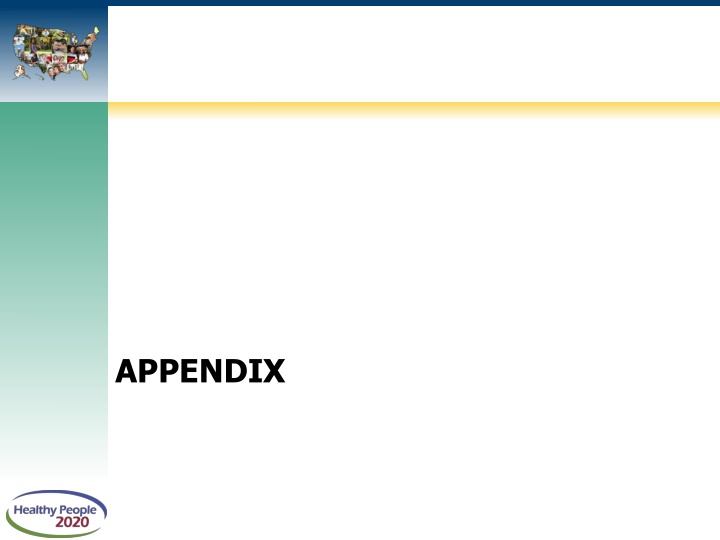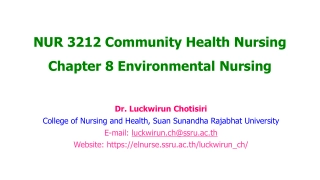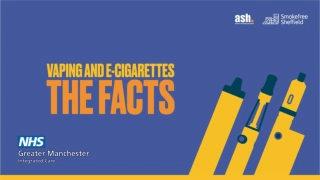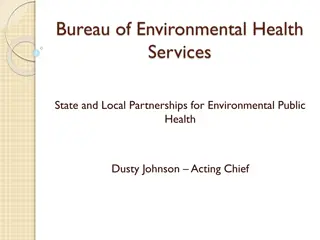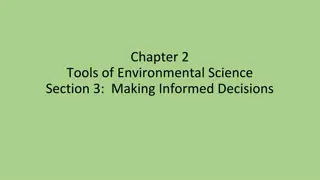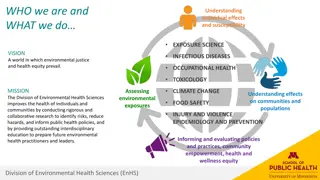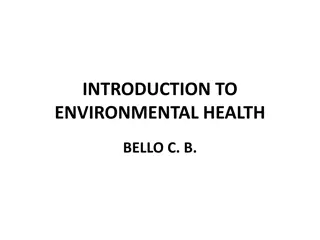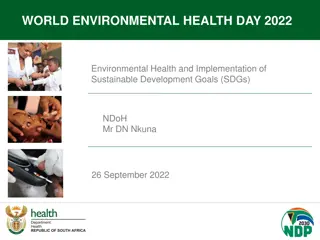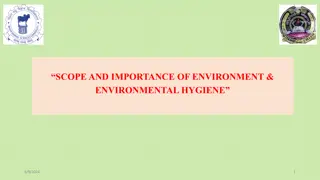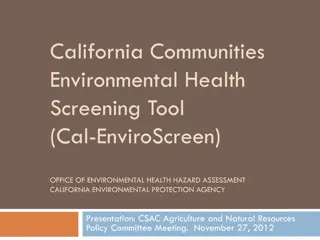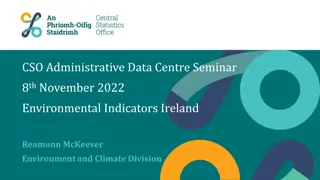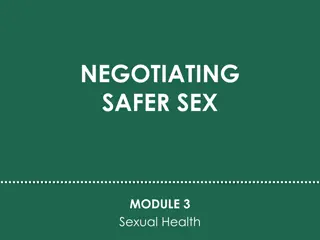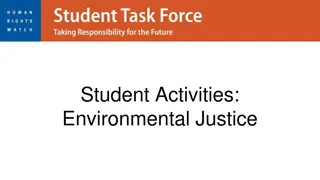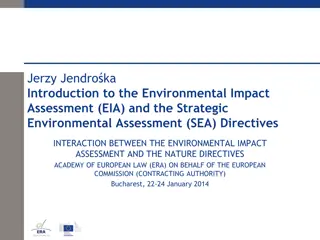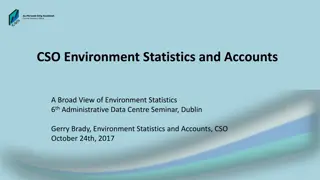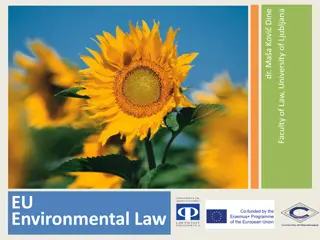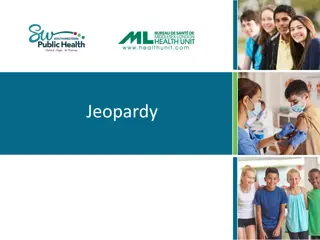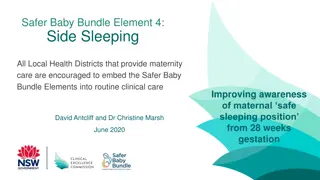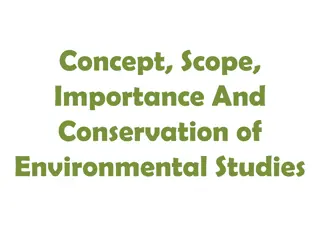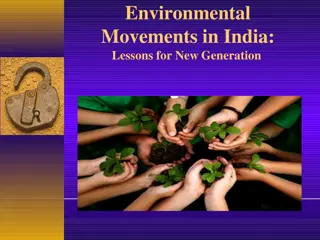Environmental Health Objectives for a Safer Future
This document outlines a comprehensive set of environmental health objectives aimed at improving air quality, water safety, waste management, and overall public health. Goals include reducing pollution, increasing recycling efforts, and minimizing health risks from hazardous substances, with a focus on creating healthier living environments for individuals of all ages.
Download Presentation

Please find below an Image/Link to download the presentation.
The content on the website is provided AS IS for your information and personal use only. It may not be sold, licensed, or shared on other websites without obtaining consent from the author.If you encounter any issues during the download, it is possible that the publisher has removed the file from their server.
You are allowed to download the files provided on this website for personal or commercial use, subject to the condition that they are used lawfully. All files are the property of their respective owners.
The content on the website is provided AS IS for your information and personal use only. It may not be sold, licensed, or shared on other websites without obtaining consent from the author.
E N D
Presentation Transcript
Objective Status: Environmental Health Target met Improving Little/No change Getting worse Baseline only Developmental EH-1 Reduce the number of days the Air Quality Index (AQI) exceeds 100 EH-2.1 Increase trips to work made by bicycling EH-2.2 Increase trips to work made by walking EH-2.3 Increase trips to work made by mass transit EH-2.4 Increase the proportion of persons who telecommute EH-3.1 Reduce the risk of adverse health effects caused by mobile sources of airborne toxics EH-3.2 Reduce the risk of adverse health effects caused by area sources of airborne toxics EH-3.3 Reduce the risk of adverse health effects caused by major sources of airborne toxics EH-4 Increase safe drinking water EH-5 Reduce waterborne disease outbreaks EH-6 Reduce per capita domestic water withdrawals with respect to use and conservation EH-7 Increase the proportion of days that beaches are open and safe for swimming EH-8.1 Reduce blood lead level in children aged 1 5 years EH-8.2 Reduce the mean blood lead levels in children EH-9 Minimize the risks to human health and the environment posed by hazardous sites EH-10 Reduce pesticide exposures that result in visits to a health care facility EH-11 Reduce the amount of toxic pollutants released into the environment 2
Objective Status: Environmental Health Target met Improving Little/No change Getting worse Baseline only Developmental EH-12 Increase recycling of municipal solid waste EH-13.1 Reduce indoor allergen levels cockroach EH-13.2 Reduce indoor allergen levels mouse EH-14 Increase the proportion of homes with an operating radon mitigation system for persons living in homes at risk for radon exposure EH-15 Increase the proportion of new single- family homes (SFH) constructed with radon- reducing features, especially in high-radon- potential areas EH-16 Increase the proportion of the Nation s elementary, middle, and high schools that have a healthy and safe physical school environment EH-16.1 Have an indoor air quality management program EH-16.2 Have a plan for how to address mold problems EH-16.3 Have a plan for how to use, label, store, and dispose of hazardous materials EH-16.4 Use spot treatments and baiting rather than widespread application of pesticide EH-16.5 Reducing exposure to pesticides by marking areas to be treated with pesticides EH-16.6 Reducing exposure to pesticides by informing students and staff prior to application of the pesticide EH-16.7 Inspecting drinking water outlets for lead EH-16.8 Inspecting drinking water outlets for bacteria EH-16.9 Inspecting drinking water outlets for coliforms 3
Objective Status: Environmental Health Target met Improving Little/No change Getting worse Baseline only Developmental EH-17.1 Increase the proportion of pre-1978 housing that has been tested for the presence of lead-based paint EH-17.2 Increase the proportion of pre-1978 housing that has been tested for the presence of paint-lead hazards EH-17.3 Increase the proportion of pre-1978 housing that has been tested for the presence of lead in dust EH-17.4 Increase the proportion of pre-1978 housing that has been tested for the presence of lead in soil EH-18.1 Reduce the number of U.S. homes that are found to have lead-based paint EH-18.2 Reduce the number of U.S. homes that have paint-lead hazards EH-18.3 Reduce the number of U.S. homes that have dust-lead hazards EH-18.4 Reduce the number of U.S. homes that have soil-lead EH-19 Reduce the proportion of occupied housing units that have moderate or severe physical problems EH-20 Reduce exposure to selected environmental chemicals in the population, as measured by blood and urine concentrations of the substances or their metabolites EH-20.1 Arsenic EH-20.2 Cadmium EH-20.3 Lead EH-20.4 Mercury (Children aged 1-5 years) EH-20.5 Mercury (Women aged 16-49 years) EH-20.6 Chlordane EH-20.7 DDT (DDE) EH-20.8 beta-hexachlorocyclohexane (beta- HCH) EH-20.9 para-nitrophenol (methyl parathion and parathions) 4
Objective Status: Environmental Health Target met Improving Little/No change Getting worse Baseline only Developmental EH-20.10 3,4,6-trichloro-2-pyridinol (chlorpyrifos) EH-20.11 3-phenoxybenzoic acid EH-20.12 PCB 153, representative of nondioxin-like PCBs EH-20.13 PCB 126, representative of dioxin- like PCBs EH-20.14 1,2,3,6,7,8-hexachlorodibenzo-p- dioxin, representative of the dioxin class EH-20.15 bisphenol A EH-20.16 perchlorate EH-20.17 mono-n-butyl phthalate EH-20.18 BDE 47 (2,2',4,4'- tetrabromodiphenyl ether) EH-21 Improve quality, utility, awareness, and use of existing information systems for environmental health EH-22 Increase the number of States, Territories, Tribes, and the District of Columbia that monitor diseases or conditions that can be caused by exposure to environmental hazards EH-22.1 Lead poisoning EH-22.2 Pesticide poisoning EH-22.3 Mercury poisoning EH-22.4 Arsenic poisoning EH-22.5 Cadmium poisoning EH-22.6 Chemical poisoning EH-22.7 Acute chemical poisoning EH-22.8 Carbon monoxide poisoning EH-23 Reduce the number of public schools located within 150 meters of major highways EH-24 Reduce the global burden of disease due to poor water quality, sanitation, and insufficient hygiene 5
Current HP2020 Objective Status: Environmental Health 6% (n=4) 10% (n=7) 16% (n=11) Target met 47% (n=32) Improving Little/No change Getting worse 10% (n=7) Baseline only Developmental 10% (n=7)
Objective Status: Tobacco Use Target met Improving Little/No change Getting worse Baseline only Developmental TU-1 Tobacco Use by Adults TU-1.1 Cigarette Smoking TU-1.2 Smokeless Tobacco Products TU-1.3 Cigars TU-2 Tobacco Use by Adolescents TU-2.1 Tobacco Products TU-2.2 Cigarettes TU-2.3 Smokeless Tobacco Products TU-2.4 Cigars TU-3 Initiation of Tobacco Use TU-3.1 Tobacco Products: Ages 12-17 TU-3.2 Cigarettes: Ages 12-17 TU-3.3 Smokeless Tobacco: Ages 12-17 TU-3.4 Cigars: Ages 12-17 TU-3.5 Tobacco Products: Ages 18-25 TU-3.6 Cigarettes: Ages 18-25 TU-3.7 Smokeless Tobacco: Ages 18-25 TU-3.8 Cigars: Ages 18-25 TU-4 and TU-5 Smoking Cessation, Adult Smokers TU-4.1 Smoking Cessation Attempts TU-4.2 Smoking Cessation Attempts Using Evidence Based Strategies TU-5.1 Recent Smoking Cessation Success TU-5.2 Recent Smoking Cessation Success Using Evidence Based Strategies TU-6 Smoking Cessation During Pregnancy TU-7 Smoking Cessation Attempts, Adolescents TU-8 Comprehensive Medicaid Coverage of Evidence Based Treatment for Nicotine Dependence TU-9 Tobacco Screening in Health Care Settings TU-9.1Office Based Ambulatory Care Settings TU-9.2 Hospital Ambulatory Care Settings TU-9.3 Dental Care Settings TU-9.4 Substance Abuse Care Settings TU-9.5 Mental Health Care Setting TU-9.6 Vision Care Settings TU-10 Tobacco Cessation Counseling in Health Care Settings TU-10.1 Office Based Ambulatory Care Settings TU-10.2 Hospital Ambulatory Care Settings TU-10.3 Dental Care Settings TU-10.4 Substance Abuse Care Settings TU-10.5 Mental Health Care Settings TU-10.6 Vision Care Settings TU-11 Secondhand Smoke Exposure, Nonsmokers TU-11.1 Children: Ages 3-11 TU-11.2 Adolescents: Ages 12-17 TU-11.3 Adults: Ages 18+ (continued on next slide )
Objective Status: Tobacco Use Target met Improving Little/No change Getting worse Baseline only Developmental (continued from previous slide ) TU-12 Indoor Worksite Policies that Prohibit Smoking TU-13 Smoke-free Indoor Air Laws TU-13.1 Private Workplaces TU-13.2 Public Workplaces TU-13.3 Restaurants TU-13.4 Bars TU-13.5 Gaming Halls TU-13.6 Day Care Centers (Commercial) TU-13.7 Day Care Centers (Home-based) TU-13.8 Public Transportation TU-13.9 Hotels and Motels TU-13.10 Multi-Unit Housing TU-13.11 Vehicles with Children TU-13.12 Prisons/Corrections Facilities TU-13.13 Substance Abuse Treatment Facilities TU-13.14 Mental Health Treatment Facilities TU-13.15 Entrances/Exits of Public Places TU-13.16 Hospital Campuses TU-13.17 College/University Campuses TU-14 Smoke Free Homes TU-15 Tobacco-Free Schools TU-15.1 Junior High Schools TU-15.2 Middle Schools TU-15.3 High Schools TU-15.4 Head Start TU-16 State Laws that Preempt Stronger Local Laws TU-16.1 Smoke-free Indoor Air TU-16.2 Advertising TU-16.3 Youth Access TU-16.4 Licensure TU-17 Federal and State Tax on Tobacco Products TU-17.1 Cigarettes TU-17.2 Smokeless Tobacco TU-17.3 Other Smoked Tobacco Products TU-18 Exposure to Tobacco Advertising and Promotion, Youth and Young Adults TU-18.1 Internet TU-18.2 Magazine and Newspaper TU-18.3 Movies TU-18.4 Point of Purchase TU-19 Illegal Sales Rate TU-19.1 States and DC TU-19.2 Territories TU-20 Evidence Based Tobacco Control Programs TU-20.1 States and DC TU-20.2 Territories TU-20.3 Tribes
Current HP2020 Objective Status: Tobacco Use 8% (n=6) 13% (n=10) 9% (n=7) 29% (n=22) Target met 5% (n=4) Improving Little/No change Getting worse 36% (n=27) Baseline only Developmental
Tobacco UseBackground Every day in the United States: The tobacco industry spends nearly 23 million to market and promote its products1 Almost 3,500 youth (under age 18) smoke their first cigarette2, 3 Approximately 2,100 youth (under age 18) who were occasional smokers become daily smokers2, 3 Approximately 1,300 people die prematurely from tobacco-related diseases (480,000 deaths annually)2 The nation spends an estimated $350 million in direct medical costs related to smoking ($130 billion annually)2 The nation experiences nearly $410 million in lost productivity due to premature deaths from tobacco-related diseases ($150 billion annually)2 SOURCES: 1. Federal Trade Commission (2011). Federal Trade Commission Cigarette Report for 2011. Available at: http://www.ftc.gov/os/2013/05/130521cigarettereport.pdf; accessed: February 21, 2014. 2. U.S. Department of Health and Human Services. The Health Consequences of Smoking 50 Years of Progress: A Report of the Surgeon General. Atlanta, GA: U.S. Department of Health and Human Services, Centers for Disease Control and Prevention, National Center for Chronic Disease Prevention and Health Promotion, Office on Smoking and Health, 2014 3. U.S. Department of Health and Human Services. Preventing Tobacco Use Among Youth and Young Adults: A Report of the Surgeon General. Atlanta: U.S. Department of Health and Human Services, Centers for Disease Control and Prevention, Office on Smoking and Health, 2012 [accessed 2014 Feb 14]. 10
Current Cigarette Smoking Among Adults Ages 18 Years and Over by Sex, 1965-2013 Percent 60 50 40 Male 30 20 Female 10 HP2020 Target: 12.0% 0 1965 1973 1981 1989 1997 2005 2013 NOTES: Data are for adults 18+ who have smoked at least 100 cigarettes in their lifetime and currently report smoking every day or some days. Data are age adjusted to the 2000 standard population. Data prior to 1997 are not strictly comparable with data for later years due to the 1997 questionnaire redesign. Obj. TU-1.1 Decrease desired SOURCE: National Health Interview Survey (NHIS), CDC/NCHS. 11
Cigarette Use in Past Month Among Students in Grades 9 12 by Grade, 2013 HP2020 Target: 16.0% NOTE: Data are for the proportion of students in grades 9 12 who used cigarettes on 1 or more of the 30 days preceding the survey. SOURCE: Youth Risk Behavior Surveillance System (YRBSS), CDC/NCCDPHP. Obj. TU-2.2 Decrease desired 12
Tobacco Initiation, Adolescents and Young Adults Percent 12 10 18-25 years HP2020 Target: 8.9% 8 6 HP2020 Target: 5.8% 12-17 years 4 2 0 2008 2009 2010 2011 2012 2013 NOTE: Data are for the percent of adolescents (ages 12-17 years) or young adults (ages 18-25 years) who previously never used tobacco who initiated tobacco use in the 12 months prior to the interview. Tobacco use includes cigarettes, snuff, chewing tobacco, and any type of cigar. Objs. TU-3.1 and TU-3.5 Decrease desired SOURCE: National Survey on Drug Use and Health (NSDUH), SAMHSA. 13
Smoking Cessation Attempts and Recent Success Among Adults, 2004-2013 Percent 100 All Attempts Recent Successes HP2020 Target: 80.0% 80 60 40 20 HP2020 Target: 8.0% 0 2004 2005 2006 2007 2008 2009 2010 2011 2012 2013 NOTES: Data are for adults 18+ and are age adjusted to the 2000 standard population. Data for smoking cessation attempts are for the percent of adult current smokers who quit smoking for more than one day in the 12 months prior to the interview OR the percent of adult former smokers abstinent less than 365 days. Data for recent cessation success are for the percent of adult smokers who ever smoked 100 cigarettes and who last smoked 6 months to one year ago. Current smokers who smoked less than 2 years are excluded from the denominator for recent cessation success. Objs. TU-4.1 and 5.1 Increase desired SOURCE: National Health Interview Survey (NHIS), CDC/NCHS. 14
Illegal Sales Rate to Minors in Compliance Checks, 2013 Percent 25 State counted towards HP2020 target (count = 10) State not counted towards HP2020 target (count = 41) HP2020 Target: 51 (States and DC) 20 15 10 5 0 NOTES: Data shown are for the percent of illegal sales to minors in compliance checks. The HP2020 objective is to, Reduce the illegal sales rate to minors through enforcement of laws prohibiting the sale of tobacco products to minors in States and District of Columbia by increasing the number of states with a 5% or less illegal sales rate to minors. The HP2020 target is 51 (50 states, plus the District of Columbia). Data shown are reported in the Federal Fiscal Year 2013 SYNAR Program reports and are from Federal Fiscal Year 2012. Obj. TU-19.1 Increase desired SOURCE: Synar Program, SAMHSA/CSAP. 15
